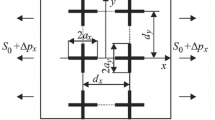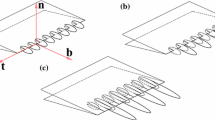Abstract
Rapid quenching of brittle materials gives rise to hierarchically ordered crack patterns. A scenario of thermal shock crack propagation can be derived: unstable propagation of several out of a great number of preexisting surface flaws leads to a transient state of cracks of nearly equal lengths and spacing. In the further process of stable multiple propagation, the progressive unloading among the cracks results in the formation of hierarchical patterns.
For equidistant parallel cracks, bifurcation and post-critical behaviour are analyzed by means of the boundary element method (BEM) applied to the exact fracture mechanical problem. Other details are investigated numerically by a simplified potential model.
The mutual inhibition of growing structural elements can be regarded as a structure forming principle which works for Laplacian structures, too.
Access this chapter
Tax calculation will be finalised at checkout
Purchases are for personal use only
Preview
Unable to display preview. Download preview PDF.
Similar content being viewed by others
References
Bahr, H.-A., Fischer, G. and Weiss, H.-J. (1986) ‘Thermal shock crack patterns explained by single and multiple crack growth’, J. Mat. Sci. 21, 2716–2720.
Bahr, H.-A., Balke. H., Kuna M. and Liesk, H. (1987) ‘Fracture analysis of a single edge cracked strip under thermal load’, Theoret. Appl. Fracture Mech. 8, 33–39.
Bahr, H.-A., Weiss, H.-J., Maschke, H.-G. and Meissner, F. (1988) ‘Multiple crack propagation in a strip caused by thermal shock’, Theoret. Appl. Fracture Mech. 10, 219–226.
Bahr, H.-A., Bahr, U. and Petzold, A. (1992)L-d deterministic crack pattern formation as a growth process with restrictions’, Europhys. Lett. 19, 485–490.
Bertsch, B. E., Larson, D. R. and Hasselman, D. P. M. (1974) ‘Effect of crack density on stress loss of polycrystalline AI,O, subjected to severe thermal shock’, J. Amer. Ceram. Soc. 57, 235.
Bueckner, H. F. (1971) ‘Weight functions for the notched bar’, Z. Angew. Math. Mech. 51, 97–109.
Blauel, J. G. (1970) ‘Thermisch induzierte elastische Spannungen und ihr Einfluß auf Auslösung und Ausbreitung von Brüchen’, Dissertation, Uni Karlsruhe.
Fischer, G. and Bahr, H.-A. (1988) ‘Induzierung von Thermoschock-Rißmustern an einseitig erwärmten Glasproben’, Proceedings VIII. Symposium Verformung und Bruch, Teil II, Magdeburg, 51.
Hasselman, D. P. H. (1969) ‘Unified theory of thermal shock fracture initiation and crack propagation of brittle ceramics’, J. Amer. Ceram. Soc. 52, 600–604
Herrmann, H.J. (1993) ‘Crack patterns generalized Laplacian structures’, these Proceedings
Maschke, H. (1988) ‘A boundary integral equation method for the problem of multiple, interacting cracks in anisotropic materials’, in E. Czoboly (ed.), Failure Analysis-Theory and Practice, Proc. 7th European Conf. on Fracture, Budapest, Hungary, EMAS U.K., pp. 161–167.
Pompe, W., Bahr, H.-A., Gille, G., Kreher, W., Schultrich, B. and Weiss, H.-J. (1985), ‘Mechanical properties of brittle materials–Modern theories and experimental evidence’, in E. Kaldis (ed.), Current topics in material science, North-Holland Publ., Amsterdam, pp. 316–360.
Pompe, W., Bahr, H.-A. and Weiss, H. J. (1991) ‘Thermal shock behaviour and crack pattern formation in brittle solids’, in J. G. M. van Mier, J. G. Rots and A. Bakker (eds.), Fracture Process in Concrete, Rock and Ceramics, RILEM 13, E. F. N. Spon, London, pp. 349–364.
Nemat-Nasser, S., Sumi, Y. and Keer, L. M. (1980) ‘Unstable growth of tension crack in brittle solids: stable and unstable bifurcations, snap-through, and imperfection sensitivity’, Int. J. Solids Structures 16, 1017–1035.
Santalo, L. A. (1976), in: Integral Geometry and Geometric Probability, Addison-Wesley, Reading, MA, p. 25.
Author information
Authors and Affiliations
Editor information
Editors and Affiliations
Rights and permissions
Copyright information
© 1993 Springer Science+Business Media Dordrecht
About this chapter
Cite this chapter
Bahr, HA., Bahr, U., Balke, H., Maschke, H., Petzold, A., Weiß, HJ. (1993). Multiple Crack Propagation under Thermal Load. In: Schneider, G.A., Petzow, G. (eds) Thermal Shock and Thermal Fatigue Behavior of Advanced Ceramics. NATO ASI Series, vol 241. Springer, Dordrecht. https://doi.org/10.1007/978-94-015-8200-1_11
Download citation
DOI: https://doi.org/10.1007/978-94-015-8200-1_11
Publisher Name: Springer, Dordrecht
Print ISBN: 978-90-481-4291-0
Online ISBN: 978-94-015-8200-1
eBook Packages: Springer Book Archive




